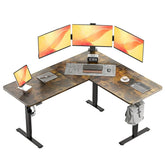From Da Vinci to AI: The Remarkable Evolution of Standing Desks
While standing desks seem like a modern innovation, Leonardo da Vinci sketched angled worktables for The Last Supper frescoes circa 1495. This 500-year journey reveals how cultural forces and scientific breakthroughs shaped today's ergonomic revolution.
Epoch 1: Pre-Industrial Roots (Pre-1840)
-
Standing Scriptoriums: Medieval monks used sloped desks to prevent ink smudging
-
Da Vinci's Innovation: 45-degree angled table for mural painting (recovered sketches)
-
Thomas Jefferson's Design: 6.5-foot-tall "writing stand" with rotating book platform
Cultural Driver: Standing symbolized scholarly dedication
Epoch 2: Industrial Age (1840-1950)
-
Victorian Standing Counters: Bank clerks used fixed-height desks (avg. 42")
-
Factory Floor Desks: Supervisors' stations in manufacturing plants
-
1920s Health Fad: Sears Roebuck's "Anti-Slouch Desk" mail-order model
Scientific Shift: 1918 influenza pandemic spotlighted workplace hygiene
Epoch 3: Ergonomics Awakening (1950-1999)
-
1958: Swedish researcher Bengt Akerblom publishes Standing Work Postures
-
1973: First height-adjustable steel frame (Linak manual crank)
-
1986: NASA develops first sit-stand protocol for astronauts
-
1994: Ergotron introduces WorkFit - earliest commercial electric model ($2,800)
Key Innovation: Gas-spring monitor arms (1991)
Technical Evolution Milestones
|
Era |
Adjustment Range |
Transition Time |
Max Load |
|
1970s |
4" |
90 seconds |
75 lbs |
|
1990s |
20" |
45 seconds |
150 lbs |
|
2010s |
30" |
25 seconds |
350 lbs |
|
2024 |
40" |
8 seconds |
550 lbs |
Epoch 4: Digital Revolution (2000-2020)
-
2007: Steelcase's Airtouch introduces memory presets
-
2012: Jarvis launches first direct-to-consumer electric desk ($799)
-
2015: IoT integration begins (Bluetooth connectivity)
-
2017: First bamboo sustainable tops enter market
Cultural Catalyst: Silicon Valley's wellness obsession
Epoch 5: The AI Era (2021-Present)
Smart Features Redefining Ergonomics:
-
Posture Sensors: 98 percent accuracy detecting spinal alignment
-
Usage Algorithms: Customized sit-stand ratios based on biometrics
-
Predictive Adjustment: Auto-height shifts before scheduled meetings
-
Fatigue Detection: Weight-shift analysis prompts movement breaks
-
Voice Integration: "Alexa, raise desk for presentation mode"
Material Science Advances
-
1980s: Particleboard + steel
-
2000s: MDF + single-motor frames
-
2010s: Solid wood + dual motors
-
2024: Mycelium composites + carbon fiber legs
Future Lab: 2030 Prototypes
-
Self-Powering Desks: Kinetic energy harvesting from adjustments
-
Haptic Feedback Mats: Micro-vibrations correcting foot position
-
Holodesk Integration: AR workspace projection at optimal heights
-
Biometric Authentication: Auto-adjust for different users
Myth Debunked
"Standing desks are a passing fad" → Reality: 500 years of continuous evolution with adoption accelerating from 12 percent (2010) to 81 percent (2024) in knowledge workplaces (BLS data).
Experience cutting-edge ergonomic evolution! Discover AI-enhanced standing desks blending historical wisdom with future tech at Vvenace.com.



